Uniform tiling
In geometry, a uniform tiling is a tessellation of the plane by regular polygon faces with the restriction of being vertex-transitive.
Uniform tilings can exist in both the Euclidean plane and hyperbolic plane. Uniform tilings are related to the finite uniform polyhedra which can be considered uniform tilings of the sphere.
Most uniform tilings can be made from a Wythoff construction starting with a symmetry group and a singular generator point inside of the fundamental domain. A planar symmetry group has a polygonal fundamental domain and can be represented by the group name represented by the order of the mirrors in sequential vertices.
A fundamental domain triangle is (p q r), and a right triangle (p q 2), where p, q, r are whole numbers greater than 1. The triangle may exist as a spherical triangle, a Euclidean plane triangle, or a hyperbolic plane triangle, depending on the values of p, q and r.
There are a number of symbolic schemes for naming these figures, from a modified Schläfli symbol for right triangle domains: (p q 2) → {p, q}. The Coxeter-Dynkin diagram is a triangular graph with p, q, r labeled on the edges. If r = 2, the graph is linear since order-2 domain nodes generate no reflections. The Wythoff symbol takes the 3 integers and separates them by a vertical bar (|). If the generator point is off the mirror opposite a domain node, it is given before the bar.
Finally tilings can be described by their vertex configuration, the sequence of polygons around each vertex.
All uniform tilings can be constructed from various operations applied to regular tilings. These operations as named by Norman Johnson are called truncation (cutting vertices), rectification (cutting vertices until edges disappear), and Cantellation (cutting edges). Omnitruncation is an operation that combines truncation and cantellation. Snubbing is an operation of Alternate truncation of the omnitruncated form. (See Uniform polyhedron#Wythoff construction operators for more details.)
Coxeter groups
Coxeter groups for the plane define the Wythoff construction and can be represented by Coxeter-Dynkin diagrams:
For groups with whole number orders, including:
| Orbifold symmetry |
Coxeter group | Coxeter diagram |
notes | ||
|---|---|---|---|---|---|
| Compact | |||||
| *333 | (3 3 3) | [3[3]] | |
3 reflective forms, 1 snub | |
| *442 | (4 4 2) | [4,4] | |
5 reflective forms, 1 snub | |
| *632 | (6 3 2) | [6,3] | |
7 reflective forms, 1 snub | |
| *2222 | (∞ 2 ∞ 2) | × | [∞,2,∞] | |
3 reflective forms, 1 snub |
| Noncompact (frieze) | |||||
| *∞∞ | (∞) | [∞] | |
||
| *22∞ | (2 2 ∞) | × | [∞,2] | |
2 reflective forms, 1 snub |
| Orbifold symmetry |
Coxeter group | Coxeter diagram |
notes | |
|---|---|---|---|---|
| Compact | ||||
| *pq2 | (p q 2) | [p,q] | |
2(p+q) < pq |
| *pqr | (p q r) | [(p,q,r)] | |
pq+pr+qr < pqr |
| Paracompact | ||||
| *∞p2 | (p ∞ 2) | [p,∞] | | p>=3 |
| *∞pq | (p q ∞) | [(p,q,∞)] | | p,q>=3, p+q>6 |
| *∞∞p | (p ∞ ∞) | [(p,∞,∞)] | | p>=3 |
| *∞∞∞ | (∞ ∞ ∞) | [(∞,∞,∞)] | | |
Uniform tilings of the Euclidean plane
There are symmetry groups on the Euclidean plane constructed from fundamental triangles: (4 4 2), (6 3 2), and (3 3 3). Each is represented by a set of lines of reflection that divide the plane into fundamental triangles.
These symmetry groups create 3 regular tilings, and 7 semiregular ones. A number of the semiregular tilings are repeated from different symmetry constructors.
A prismatic symmetry group represented by (2 2 2 2) represents by two sets of parallel mirrors, which in general can have a rectangular fundamental domain. It generates no new tilings.
A further prismatic symmetry group represented by (∞ 2 2) which has an infinite fundamental domain. It constructs two uniform tilings, the apeirogonal prism and apeirogonal antiprism.
The stacking of the finite faces of these two prismatic tilings constructs one non-Wythoffian uniform tiling of the plane. It is called the elongated triangular tiling, composed of alternating layers of squares and triangles.
Right angle fundamental triangles: (p q 2)
| (p q 2) | Fund. triangles |
Parent | Truncated | Rectified | Bitruncated | Birectified (dual) |
Cantellated | Omnitruncated (Cantitruncated) |
Snub |
|---|---|---|---|---|---|---|---|---|---|
| Wythoff symbol | q | p 2 | 2 q | p | 2 | p q | 2 p | q | p | q 2 | p q | 2 | p q 2 | | | p q 2 | |
| Schläfli symbol | t{p,q} | t{p,q} | r{p,q} | 2t{p,q}=t{q,p} | 2r{p,q}={q,p} | rr{p,q} | tr{p,q} | sr{p,q} | |
| Coxeter diagram | |||||||||
| Vertex config. | pq | q.2p.2p | (p.q)2 | p.2q.2q | qp | p.4.q.4 | 4.2p.2q | 3.3.p.3.q | |
| Square tiling (4 4 2) |
 |
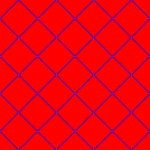 {4,4} |
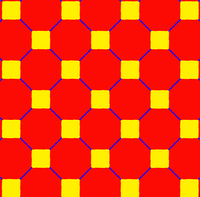 4.8.8 |
 4.4.4.4 |
 4.8.8 |
 {4,4} |
 4.4.4.4 |
 4.8.8 |
 3.3.4.3.4 |
| Hexagonal tiling (6 3 2) |
 |
 {6,3} |
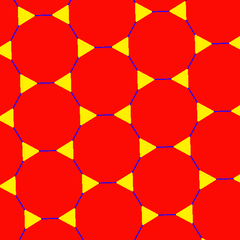 3.12.12 |
 3.6.3.6 |
 6.6.6 |
 {3,6} |
 3.4.6.4 |
 4.6.12 |
 3.3.3.3.6 |
General fundamental triangles: (p q r)
| Wythoff symbol (p q r) |
Fund. triangles |
q | p r | r q | p | r | p q | r p | q | p | q r | p q | r | p q r | | | p q r |
|---|---|---|---|---|---|---|---|---|---|
| Coxeter diagram | |||||||||
| Vertex config. | (p.q)r | r.2p.q.2p | (p.r)q | q.2r.p.2r | (q.r)p | q.2r.p.2r | r.2q.p.2q | 3.r.3.q.3.p | |
| Triangular (3 3 3) |
 |
 (3.3)3 |
 3.6.3.6 |
 (3.3)3 |
 3.6.3.6 |
 (3.3)3 |
 3.6.3.6 |
 6.6.6 |
 3.3.3.3.3.3 |
Non-simplical fundamental domains
The only possible fundamental domain in Euclidean 2-space that is not a simplex is the rectangle (∞ 2 ∞ 2), with Coxeter diagram: ![]()
![]()
![]()
![]()
![]()
![]()
![]() . All forms generated from it become a square tiling.
. All forms generated from it become a square tiling.
Uniform tilings of the hyperbolic plane
There are infinitely many uniform tilings of convex regular polygons on the hyperbolic plane, each based on a different reflective symmetry group (p q r).
A sampling is shown here with a Poincaré disk projection.
The Coxeter-Dynkin diagram is given in a linear form, although it is actually a triangle, with the trailing segment r connecting to the first node.
Further symmetry groups exist in the hyperbolic plane with quadrilateral fundamental domains starting with (2 2 2 3), etc., that can generate new forms. As well there's fundamental domains that place vertices at infinity, such as (∞ 2 3), etc.
Right angle fundamental triangles: (p q 2)
| (p q 2) | Fund. triangles |
Parent | Truncated | Rectified | Bitruncated | Birectified (dual) |
Cantellated | Omnitruncated (Cantitruncated) |
Snub |
|---|---|---|---|---|---|---|---|---|---|
| Wythoff symbol | q | p 2 | 2 q | p | 2 | p q | 2 p | q | p | q 2 | p q | 2 | p q 2 | | | p q 2 | |
| Schläfli symbol | t{p,q} | t{p,q} | r{p,q} | 2t{p,q}=t{q,p} | 2r{p,q}={q,p} | rr{p,q} | tr{p,q} | sr{p,q} | |
| Coxeter-Dynkin diagram | |||||||||
| Vertex figure | pq | (q.2p.2p) | (p.q.p.q) | (p. 2q.2q) | qp | (p. 4.q.4) | (4.2p.2q) | (3.3.p. 3.q) | |
| (Hyperbolic plane) (5 4 2) |
 V4.8.10 |
 {5,4} |
 4.10.10 |
 4.5.4.5 |
 5.8.8 |
 {4,5} |
 4.4.5.4 |
 4.8.10 |
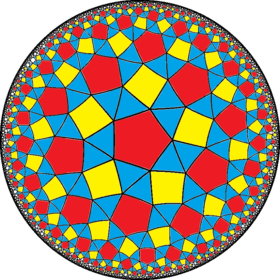 3.3.4.3.5 |
| (Hyperbolic plane) (5 5 2) |
 V4.10.10 |
 {5,5} |
 5.10.10 |
 5.5.5.5 |
 5.10.10 |
 {5,5} |
 5.4.5.4 |
 4.10.10 |
 3.3.5.3.5 |
| (Hyperbolic plane) (7 3 2) |
 V4.6.14 |
 {7,3} |
 3.14.14 |
 3.7.3.7 |
 7.6.6 |
 {3,7} |
 3.4.7.4 |
 4.6.14 |
 3.3.3.3.7 |
| (Hyperbolic plane) (8 3 2) |
 V4.6.16 |
 {8,3} |
 3.16.16 |
 3.8.3.8 |
 8.6.6 |
 {3,8} |
 3.4.8.4 |
 4.6.16 |
 3.3.3.3.8 |
General fundamental triangles (p q r)
| Wythoff symbol (p q r) |
Fund. triangles |
q | p r | r q | p | r | p q | r p | q | p | q r | p q | r | p q r | | | p q r |
|---|---|---|---|---|---|---|---|---|---|
| Coxeter-Dynkin diagram | |||||||||
| Vertex figure | (p.r)q | (r.2p.q.2p) | (p.q)r | (q.2r.p. 2r) | (q.r)p | (r.2q.p. 2q) | (2p.2q.2r) | (3.r.3.q.3.p) | |
| Hyperbolic (4 3 3) |
 V6.6.8 |
 (3.4)3 |
 3.8.3.8 |
 (3.4)3 |
 3.6.4.6 |
 (3.3)4 |
 3.6.4.6 |
 6.6.8 |
 3.3.3.3.3.4 |
| Hyperbolic (4 4 3) |
 V6.8.8 |
 (3.4)4 |
 3.8.4.8 |
 (4.4)3 |
 3.6.4.6 |
 (3.4)4 |
 4.6.4.6 |
 6.8.8 |
 3.3.3.4.3.4 |
| Hyperbolic (4 4 4) |
 V8.8.8 |
 (4.4)4 |
 4.8.4.8 |
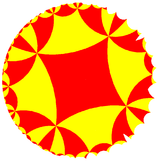 (4.4)4 |
 4.8.4.8 |
 (4.4)4 |
 4.8.4.8 |
 8.8.8 |
 3.4.3.4.3.4 |
Expanded lists of uniform tilings
There are a number ways the list of uniform tilings can be expanded:
- Vertex figures can have retrograde faces and turn around the vertex more than once.
- Star polygons tiles can be included.
- Apeirogons, {∞}, can be used as tiling faces.
- The restriction that tiles meet edge-to-edge can be relaxed, allowing additional tilings such as the Pythagorean tiling.
Symmetry group triangles with retrogrades include:
- (4/3 4/3 2) (6 3/2 2) (6/5 3 2) (6 6/5 3) (6 6 3/2)
Symmetry group triangles with infinity include:
- (4 4/3 ∞) (3/2 3 ∞) (6 6/5 ∞) (3 3/2 ∞)
Branko Grünbaum, in the 1987 book Tilings and patterns, in section 12.3 enumerates a list of 25 uniform tilings, including the 11 convex forms, and adds 14 more he calls hollow tilings which included the first two expansions above, star polygon faces and vertex figures.
H.S.M. Coxeter et al., in the 1954 paper 'Uniform polyhedra', in Table 8: Uniform Tessellations, uses the first three expansions and enumerates a total of 38 uniform tilings.
Finally, if a tiling made of 2 apeirogons is also counted, the total can be considered 39 uniform tilings.
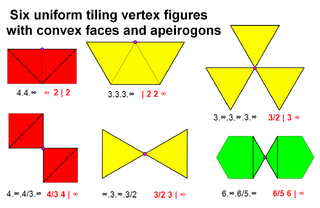
The 7 new tilings with {∞} tiles, given by vertex figure and Wythoff symbol are:
- ∞.∞ (Two half-plane tiles, infinite dihedron)
- 4.4.∞ - ∞ 2 | 2 (Apeirogonal prism)
- 3.3.3.∞ - | 2 2 ∞ (Apeirogonal antiprism)
- 4.∞.4/3.∞ - 4/3 4 | ∞ (alternate square tiling)
- 3.∞.3.∞.3.∞ - 3/2 | 3 ∞ (alternate triangular tiling)
- 6.∞.6/5.∞ - 6/5 6 | ∞ (alternate trihexagonal tiling with only hexagons)
- ∞.3.∞.3/2 - 3/2 3 | ∞ (alternate trihexagonal tiling with only triangles)
The remaining list includes 21 tilings, 7 with {∞} tiles (apeirogons). Drawn as edge-graphs there are only 14 unique tilings, and the first is identical to the 3.4.6.4 tiling.

The 21 grouped by shared edge graphs, given by vertex figures and Wythoff symbol, are:
| Type | Vertex configuration |
Wythoff symbol |
|---|---|---|
| 1 | 3/2.12.6.12 | 3/2 6 | 6 |
| 4.12.4/3.12/11 | 2 6 (3/2 3) | | |
| 2 | 8/3.4.8/3.∞ | 4 ∞ | 4/3 |
| 8/3.8.8/5.8/7 | 4/3 4 (2 ∞) | | |
| 8.4/3.8.∞ | 4/3 ∞ | 4 | |
| 3 | 12/5.6.12/5.∞ | 6 ∞ | 6/5 |
| 12/5.12.12/7.12/11 | 6/5 6 (3 ∞) | | |
| 12.6/5.12.∞ | 6/5 ∞ | 6 | |
| 4 | 12/5.3.12/5.6/5 | 3 6 | 6/5 |
| 12/5.4.12/7.4/3 | 2 6/5 (3/2 3) | | |
| 4.3/2.4.6/5 | 3/2 6 | 2 | |
| 5 | 8.8/3.∞ | 4/3 4 ∞ | |
| 6 | 12.12/5.∞ | 6/5 6 ∞ | |
| 7 | 8.4/3.8/5 | 2 4/3 4 | |
| 8 | 6.4/3.12/7 | 2 3 6/5 | |
| 9 | 12.6/5.12/7 | 3 6/5 6 | |
| 10 | 4.8/5.8/5 | 2 4 | 4/3 |
| 11 | 12/5.12/5.3/2 | 2 3 | 6/5 |
| 12 | 4.4.3/2.3/2.3/2 | non-Wythoffian |
| 13 | 4.3/2.4.3/2.3/2 | | 2 4/3 4/3 (snub) |
| 14 | 3.4.3.4/3.3.∞ | | 4/3 4 ∞ (snub) |
Self-dual tilings
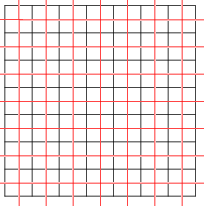
Tilings can also be self-dual. The square tiling, with Schlafli symbol {4,4}, is self-dual; shown here are two square tilings (red and black), dual to each other.
See also
| Wikimedia Commons has media related to Uniform tilings. |
References
- Norman Johnson Uniform Polytopes, Manuscript (1991)
- N.W. Johnson: The Theory of Uniform Polytopes and Honeycombs, Ph.D. Dissertation, University of Toronto, 1966
- Grünbaum, Branko; Shephard, G. C. (1987). Tilings and Patterns. W. H. Freeman and Company. ISBN 0-7167-1193-1. (Star tilings section 12.3)
- H. S. M. Coxeter, M. S. Longuet-Higgins, J. C. P. Miller, Uniform polyhedra, Phil. Trans. 1954, 246 A, 401–50 JSTOR 91532 (Table 8)
External links
- Uniform Tessellations on the Euclid plane
- Tessellations of the Plane
- David Bailey's World of Tessellations
- k-uniform tilings
- n-uniform tilings
- Klitzing, Richard. "4D Euclidean tilings".
Fundamental convex regular and uniform honeycombs in dimensions 2-9 | ||||||
|---|---|---|---|---|---|---|
| Space | Family | / / | ||||
| E2 | Uniform tiling | {3[3]} | δ3 | hδ3 | qδ3 | Hexagonal |
| E3 | Uniform convex honeycomb | {3[4]} | δ4 | hδ4 | qδ4 | |
| E4 | Uniform 4-honeycomb | {3[5]} | δ5 | hδ5 | qδ5 | 24-cell honeycomb |
| E5 | Uniform 5-honeycomb | {3[6]} | δ6 | hδ6 | qδ6 | |
| E6 | Uniform 6-honeycomb | {3[7]} | δ7 | hδ7 | qδ7 | 222 |
| E7 | Uniform 7-honeycomb | {3[8]} | δ8 | hδ8 | qδ8 | 133 • 331 |
| E8 | Uniform 8-honeycomb | {3[9]} | δ9 | hδ9 | qδ9 | 152 • 251 • 521 |
| E9 | Uniform 9-honeycomb | {3[10]} | δ10 | hδ10 | qδ10 | |
| En-1 | Uniform (n-1)-honeycomb | {3[n]} | δn | hδn | qδn | 1k2 • 2k1 • k21 |
